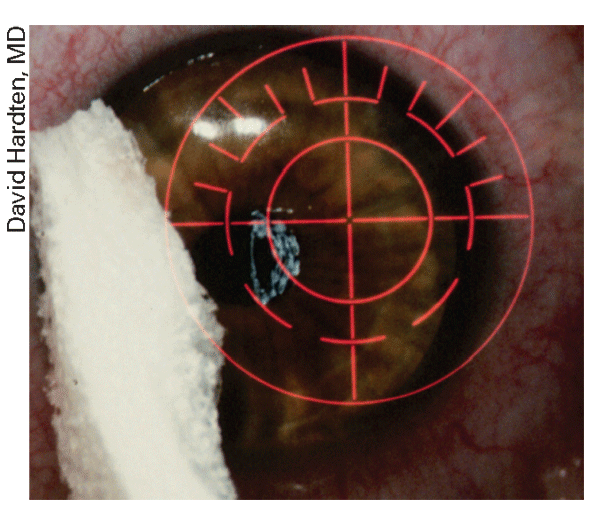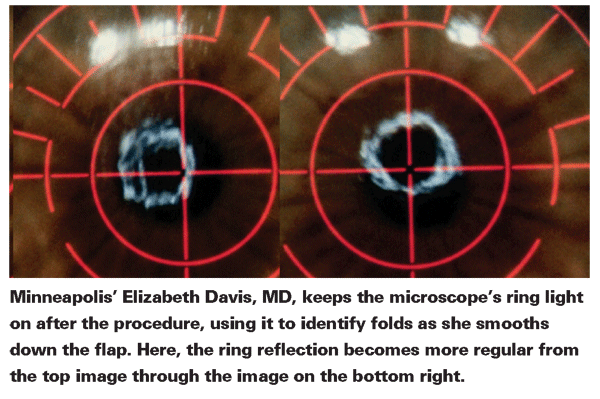Even the best performers in life occasionally need a little help to meet their usual high standards of quality. LeBron James needs well-timed assists and Formula-1 cars need accurate tune-ups. LASIK is no exception. Despite careful planning and a well-performed procedure, there are those cases that don't turn out as the patient or surgeon hoped, and require an enhancement. Though results with enhancements are almost always good, experts say these secondary procedures aren't to be taken lightly. Here are several surgeons' tips for managing these cases.
When to Enhance
Refractive surgeons say a LASIK patient has to meet certain criteria before they'd go ahead with an enhancement.
"The first thing is we should have '20/Happy' as a goal, not necessarily 20/20," says Jerry Hu, MD, of
If patients aren't happy with their vision, though, it pays to investigate other possible causes, say surgeons. "I usually make sure that the patient's complaint correlates with his refraction," says Samir Melki, MD, PhD, of the Boston Eye Group. "I make sure there isn't something else going on that might be making him unhappy with the vision, such as dry eye, a corneal irregularity or anything other than the refraction that might be causing the complaint."
Bogotá
In older patients, there's also the possibility that the problem isn't with their LASIK at all. "The patient could be developing a cataract," says Elizabeth Davis, MD, of
"Another scenario where I'm careful about doing an enhancement is the presbyope who ends up with unintended monovision," says Dr. Davis. "Your original goal with the LASIK was to correct both eyes for distance, but they ended up with one eye on target and the other a little undercorrected. As a result, the patient got the benefit of not having to use reading glasses, but he's not really aware of it. He just knows that one eye seems blurry when looking at distance. If you're not careful and just enhance the undercorrected eye, the next morning the patient will wake up and find he's unable to see anything up close, and will wish he'd never had the enhancement. In these patients, I sometimes will cover up their undercorrected eye and have them look at something close with their distance eye and say, 'If you do the enhancement, everything up close will look like this.' They'll often say, 'Whoa, I don't know if I like that,' and will choose to leave it alone."
Performing the Enhancement
If you feel that the patient has a legitimate complaint that warrants an enhancement, he still has to be a good candidate.
"I use enhancements in normal corneas with sufficient stromal tissue," says Dr. Tamayo. You should also make sure the eye isn't showing signs keratoconus.
Most of the surgeons we spoke to would wait four to six months before enhancing to ensure refractive stability. "With an overcorrection after a myopic procedure, the vision may self-correct," says Dr. Hu. "You may have to wait five or six months."
Most surgeons prefer to relift the flap, though surface ablation over the previous flap is becoming accepted.
"I'll never recut," says Dr. Davis. "The recut can potentially pass up and down through the primary flap and result in loose pieces of stroma and irregular astigmatism. I'll relift some flaps, but we're starting to do surface ablation enhancements after LASIK more and more because they decrease the risk of epithelial ingrowth and don't weaken the corneal biomechanics as much as ablating beneath a flap does." Surgeons who do surface ablation enhancements usually use mitomycin-C as an adjunct. Dr. Davis'regimen is 0.2 mg/ml for 12 seconds.

Dr. Hu will recut a flap in very specific circumstances. "If the flap has been in place for three years or less, I'm inclined toward lifting it and retreating the bed," he says. "However, if the original surgery was performed more than three years ago, I think it's much better to recut the flap. This can be done very safely with the IntraLase. The reason is when you relift a flap, there's always a risk of epithelial ingrowth. Whereas if you recut, it's a safe option; the patient essentially undergoes another LASIK surgery and will have less chance of ingrowth."
Dr. Hu says if the original flap was done with a microkeratome, its thickness is likely in the 160-µm range. When recutting with the IntraLase in that case, he'll program the laser to cut a thin flap, 100 to 120 µm, so it will stay safely above the original interface. Other surgeons say to make sure of the original flap thickness before attempting a recut.
When it comes to relifting flaps, many surgeons have their own methods. Here's the technique favored by Michael Taravella, MD, director of cornea and refractive surgery at the
If the bed will be big enough, Dr. Taravella finds the flap edge at the slit lamp under topical anesthesia and uses a Machat spatula to lift just the edge. "Once the flap edge is found, stop and place the patient under the laser," he advises. "Complete the lift with the blunt end of the spatula. I suggest a sweeping motion, starting at the initial edge found at the slit lamp and working your way under the flap, past the center, toward the edge of the flap 360 degrees. Remember to respect the curvature of the cornea so that the tip of the spatula doesn't perforate the flap. Watch for adherence, especially in the center of the flap. Remember that flaps cut with a microkeratome are much thinner in the center and tend to be more adherent. If you can't free up this area, stop, lay the flap down and wait for a few months for it to heal before doing a surface treatment. If the flap is freed up, fold it over and apply traction to the flap edge and use a motion similar to capsulorhexis, almost a circular tear movement, following the edge of the flap. Epithelium tends to tear cleanly and doesn't leave a ragged edge."
Dr. Davis makes a point of heading off ingrowth. "If there are tags of epithelium lying on the stromal bed at the edge after you lift the flap, push them back with a sponge before you refloat the flap back," she says.



